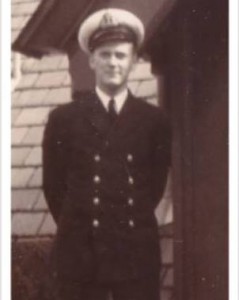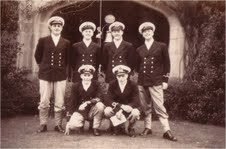
(Click on photo for better viewing)
Greetings
Some of you may have noticed a slight absence of articles from me recently. The past few months have been very busy, as I was married in March and relocated to Vancouver to be with my husband. It was harder than I thought to leave Victoria and my work at Royal Roads, which is why I am extremely happy that my connection with the ex-cadets will continue, as Royal Roads University has kindly granted me a small contract to continue working on military heritage and liaising with our ex-cadet alumni. I was also extremely surprised and gratified last month when I attended the Vancouver Island Ex-Cadet Luncheon and was granted an honourary membership in the club – both marriage and becoming an honourary ex-cadet all in one year – what more could I ask for? J I am looking forward to continuing to meet more of you and hear of your stories (both RRMC days and post-RRMC).
Karen Inkster-Vance
Royal Roads and the Navy: 1941-42
Since this year marks the centennial of the Canadian Navy, I thought it appropriate to share some of Royal Roads’ origins as a naval officer training facility during WWII. I’d also be interested in hearing some of your recollections of naval traditions at Royal Roads – any terminology or traditions that continued throughout the years even after becoming tri-service.
HMCS Royal Roads
Caption Photo above: 3rd Class of 90 Day Wonders in front of castle_1941
 Between 1941-42 HMCS Royal Roads graduated 500 officers after just three months’ training to go overseas as Temporary Acting Probationary Sub-Lieutenants. Most of them served aboard corvettes on convoys crossing the Atlantic. They were jokingly known as ‘90 Day Wonders’.
Between 1941-42 HMCS Royal Roads graduated 500 officers after just three months’ training to go overseas as Temporary Acting Probationary Sub-Lieutenants. Most of them served aboard corvettes on convoys crossing the Atlantic. They were jokingly known as ‘90 Day Wonders’.
Caption Photo left: George Johnson (3rd Class 1941) became a medical doctor, served as a cabinet member in Manitoba for two governments, and was the province’s Lieutenant Governor from 1986 to 1993. He attended HMCS Royal Roads in the Fall of 1941, and served in the Canadian Navy until the end of the war. He received an honourary doctorate from RRMC in 1995.
All cadets slept and ate in the castle; the Dunsmuirs’ drawing room on the first floor became the cadet gunroom. The bedrooms and ballroom on the third and fourth floors were converted to ‘cabins’ and all of the mattresses, linens, crockery and cutlery for the newly created college came from the CN Steamship Prince Robert. The Italian gardens were used as the Quarterdeck until the Grant Block was created, and the East Lawn was used as the parade ground.
The White Ensign of the navy was flown from the mast in front of the Castle until the Canadian flag was adopted in 1965. Many other naval traditions stayed well throughout the history of the military college, including saluting the Quarterdeck, having kye and biscuits in the evening and using a bosun’s whistle to waken the cadets. The ship’s bell hung in the porte-cochere outside the castle. It is currently housed in the Naden Museum, but will be returned to Royal Roads as part of the Homecoming 2010 ceremonies this coming September.
The following article was recently printed in the Victoria Times Colonist by Dave Obee, and explains in more detail the history of the naval college system in Canada and at Royal Roads: http://www.timescolonist.com/news/Military+college+reborn+1942/3148906/story.html#ixzz0sBZ8bwSf
Naval Tradition Request for Information:
RRU Archivist, Sarah Elizabeth Holland and I often get interesting requests for information from the public, and this one stumped us so I thought I would put it out there to see if any of you might be able to assist. An 80 year old gentleman read the above article and phoned us asking if we knew anything further about the tradition of chipping steel into a square shape as it was described in the article:
“Harry Kingsley, a retired navy captain, wrote in the Daily Colonist in 1966 that one of the first tasks assigned the students was the chipping of a piece of steel to a square shape with a hammer and chisel. It was impossible to do it without occasionally hitting the knuckles of your hand — but as Kingsley noted, that still left one good hand for taking notes.”
Apparently the 80 year old gentleman also had to do this as a form of initiation when he was 16 years old working in a shipyard in Glasgow (he was not in the navy). He is just interested in the strangeness of the assignment and is wondering if there is any further information about the tradition. If anyone can shed any light on this, or has any additional anecdotes, please email me at: Karen.inkster@royalroads.ca.
Royal Roads Homecoming Reunion Weekend – Sep 10-12, 2010
This year’s homecoming will be held on the weekend of September 10-12 and all RR ex-cadets and their classmates are welcome to attend. In particular, the RRMC classes of 1958-60, 1963-65 and 1968-70 will be holding their class reunions at Royal Roads at this time. This year promises to be extra special, with the return of the HMCS Royal Roads bell as part of the Naval Centennial, and the rededication of the mast plaza, with members of the class of 1943-45 coming to celebrate. As in years past the Navy will sponsor a day sail aboard the HMCS Calgary for ex-cadet and university alumni. We encourage other classes or individuals who wish to attend to contact: homecoming@royalroads.ca to make arrangements. Registration and details can be found online at: www.royalroads.ca/homecoming .
xxxxxx



